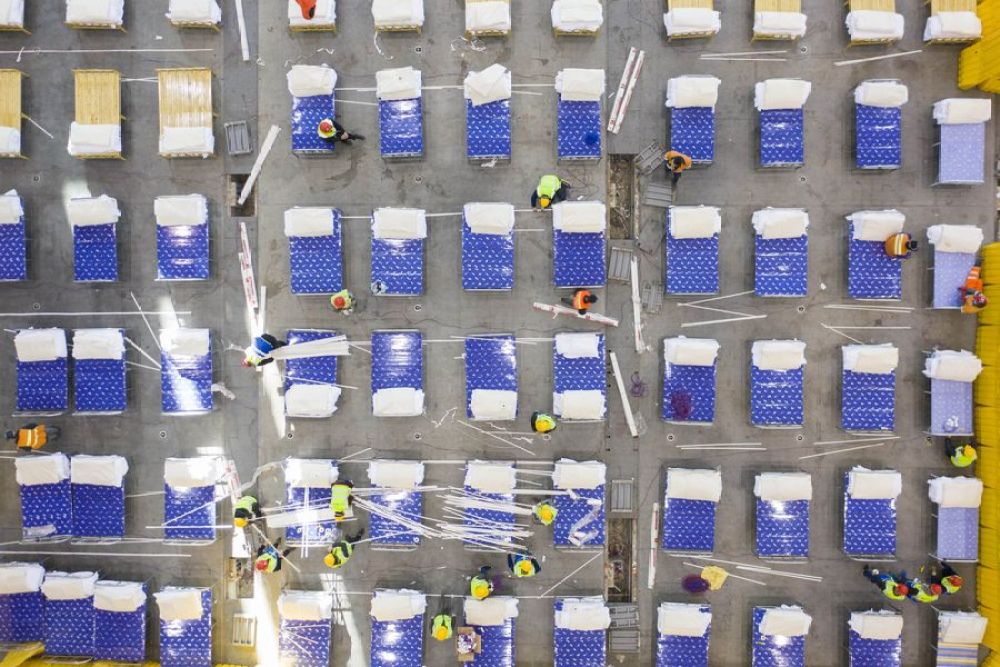Xinhua Headlines: Wuhan creates more hospitals as gov't vows to leave no virus patient unattended
英文全媒头条:武汉建造更多医院,力保患者“应收尽收”“应治尽治”
Faced with the daunting task of treating an overwhelmingly large number of coronavirus-infected patients, Wuhan is racing to convert various venues into makeshift hospitals. A leading health expert said it is a key measure taken by the Chinese authorities at a critical time.
by Zhou Erjie, Liao Jun, Wang Zuokui
WUHAN, Feb. 5 (Xinhua) -- The Chinese city of Wuhan, the epicenter of the novel coronavirus outbreak, is racing to create more temporary hospitals to cope with the surging number of patients infected with the virus.
Wuhan, the capital of Hubei Province, has converted an exhibition center into a hospital with 1,800 beds. As of Wednesday afternoon, conversion work has started on 10 other venues, including gymnasiums, sports centers and a high school, and two more such hospitals have been planned. They can provide a total of over 10,000 beds.
The move, which experts say is unprecedented in China, came as the hard-hit city is grappling to provide beds for over 8,000 infected patients and provincial authorities vowed to leave no patient unattended.

Workers are busy converting Wuhan International Conference and Exhibition Center into a makeshift hospital in Wuhan, Feb. 4, 2020. (Xinhua/Cai Yang)
UNPRECEDENTED MOVE
"Putting into operation temporary hospitals with a large number of beds inside a giant space is a major public health measure China has taken," said Wang Chen, a renowned respiratory expert and president of the Chinese Academy of Medical Sciences.
"It is a key measure taken by the authorities at a critical time," said Wang. "Unlike field hospitals during wartime or quake-relief efforts, the makeshift hospitals in Wuhan are unprecedented in China."
The temporary hospitals, located in different districts of the city, will take in patients with mild symptoms caused by the coronavirus. They will receive basic medical care there and will be transferred to standard hospitals if their sickness worsens.
Wang said the new measure is specifically designed to address the pressing issue of virus transmission in households and communities.
"If a large number of patients with mild symptoms live at home or suspected patients roam around in the community, they will become the main source to spread the virus," Wang said.
Moreover, as hospital beds are in short supply, their lives could be in danger if they are not effectively treated, the expert added.

Aerial photo taken on Feb. 4, 2020 shows the interior of "Wuhan Livingroom", a venue converted into a makeshift hospital to receive patients infected with the novel coronavirus, in Wuhan. (Xinhua/Cai Yang)
At a cultural building complex dubbed "Wuhan Livingroom," workers are working around the clock to put 2,000 beds in place.
The main section of the complex, which is designed to accommodate 1,000 beds, will be divided into 20 nursing units. Shower rooms, restrooms and washing areas will be set up outside the main venue.
"Although the facilitates are relatively crude, the design standards have not been compromised," said Li Li, the main designer of the makeshift hospital, adding that its layout aimed to prevent medical personnel from getting infected.
"The entry and exit are separated to avoid cross infection," said Li. "On the way to the exit, the process of disinfection, removing protective suits and showering is strictly implemented to protect the safety of medical personnel."
Wang Ying, a staff member of Zhongnan Hospital of Wuhan University, is overseeing the conversion work at the Hongshan Gymnasium, where 800 beds have been placed.
"Though this is not a standard hospital, we have designed medical procedures that will reach the infection control standards of a standard hospital," said Wang.
Wang added that the wastewater of the hospital will be disinfected before being discharged.

Photo taken on Feb. 4, 2020 shows an interior view of the Hongshan Gymnasium, a venue converted into a makeshift hospital to receive patients infected with the novel coronavirus. (Xinhua/Xiong Qi)
NO PATIENT LEFT UNATTENDED
Faced with the daunting task of treating an overwhelmingly large number of patients, the Hubei provincial authorities have stepped up efforts to build and create more medical facilities.
The measure to transform existing venues into makeshift hospitals came after Wuhan had previously planned two hospitals, Huoshenshan and Leishenshan, which were dedicated to treating coronavirus-infected patients with 2,600 beds in total.
Huoshenshan, which was delivered on Sunday after a 10-day construction, began accepting patients on Tuesday. Leishenshan is under construction.
At a meeting on late Monday, the Hubei provincial Party leadership urged efforts to take over venues such as hotels, private hospitals and exhibition centers in accordance with the law when necessary, in a bid to "ensure enough hospital beds are readied" to treat the patients.
On Tuesday, Jiang Chaoliang, Party chief of Hubei, vowed to leave no patient unattended, reaffirming the pledge to "accept all patients who need to be admitted to hospitals and treat all those who need to be treated."
(Feng Guodong and Yue Wenwan contributed to the story. Video reporters: Feng Guodong, Liao Jun, Dong Bohan; Video editor: Lin Lin)■





请输入验证码